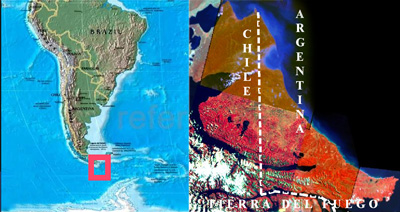 Location Location
Focus basins are located in the province of Tierra del Fuego.
Tierra del Fuego is an island located in the extreme south of Argentina and Chile separated from the continent by the Magallanes Straight.
The focus basins are located in the Mountain zone of Tierra del Fuego island.
Mountain basins occupy the area between Fueguin Andes Mountain Range and Beagle Channel. They present glacio-snowy hydrological regime, soils of scarce depth and eventual slides and avalanches.
The stream network presents high density, short paths, strong slopes and moderated flows. Runoff is mainly regulated by seasonal snow, mires, mountain range detritus storages and contributing glaciers. There is also another type of storage such as lakes, which genesis is associated with glacier and periglacier processes.
Seasonal snow is the storage with higher regulation capacity; it’s possible to appreciate snow accumulation in the whole basin but it has more important development and stability at the high levels of the basin.
These basins present some typical features related with the austral andean mountain range environment.
Predominant vegetation in mountain basins is mesophile forest in the following varieties: caducifolias Nothofagus Pumilio (lenga), Nothofagus Antártica (ñire) and perennifolia Nothofagus. Betuloides (guindo o coihue from magallanes) (Roig, 1998) often associated with Drimys winteri (Canelo). The superior forest boundary is at 600 m altitude, but it may vary around ± 100m depending on the slope sun exposition and on the sea proximity, which attenuates thermal oscillations (Puigdefabregas et al, 1988).
Forest log activities in the region are becoming more important nowadays and this fact may produce some hydrological changes, mainly in slope areas, which are predominant in these basins. Likewise, current and short-term tourist development will change the unaltered conditions of these basins.
Some hydrological problems eventually occur in these basins such as snow avalanches and soil slips that affect wide slopes sectors. These situations are generally related with major rainfall events on the middle and high catchment sectors. In that condition it’s possible to observe large woody debris (LWD), dramatically altering channel flow and morphology as well as the catchment sediment response.
The impact of this kind of phenomenon varies depending on precipitation intensity and on the basin forest conditions. In the case of unaltered forests, during a major rainfall event, the important presence of LWD in some mountain water courses usually causes serious damage over the bridges and roads infrastructure.
Project focus basins
|



